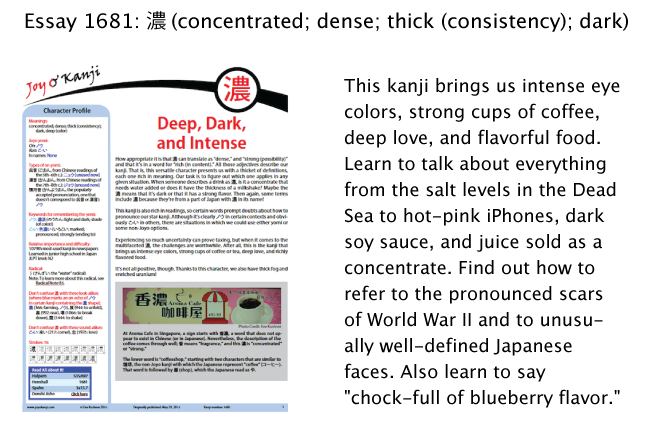Facing Up to Facts
In writing essay 1681 on 濃 (concentrated; dense; thick (consistency); dark, deep (color)), I learned about this pair of colloquial antonyms:
濃い顔 (こいかお: unusually well-defined Japanese face) strong + face
薄い顔 (うすいかお: typical Japanese face) weak + face
The idea is that if a Japanese person has a well-defined face or clear-cut features, that brings to mind a Western or Middle Eastern look.
I was struck by the Japanese use of 薄, "weak," to refer to a typical Japanese face. How odd to perceive one's own inherent look as problematic. I also noticed the "well-defined" in the English (which my proofreader supplied). It's hard to escape the idea of "well" as positive. What's going on here?
It turns out that 濃い顔 has a neutral nuance and that, if anything, it might tilt toward the negative side just by virtue of being atypical. Ah, I had it backward! I'm relieved. I would hate to think that a whole country considered its facial features to be weak.
But then look what else the Japanese used to call their own faces:
しょうゆ顔 (しょうゆがお: soy sauce face)
This term, which people seldom use now, alludes to the prevalence of soy sauce in Japanese cuisine and refers to the standard Japanese face. This expression contrasts with one for Japanese faces that don't look Japanese:
ソース顔 (ソースがお: sauce face)
As if that weren't already a lot to take in, one blogger has categorized several more “seasoning faces”! Aside from the two sauce faces included in the blog, my proofreader has never heard of the terms mentioned there, but let's look at them in the form of a quiz!
Part I. See if you can match the kanji, the yomi, and the English:
| 1. 塩顔 | a. すがお | i. salt face |
| 2. 酢顔 | b. さとうがお | ii. sugar face |
| 3. 砂糖顔 | c. しおがお | iii. vinegar face |
Part II. See if you can match the type of face to the description:
| 4. みそ顔 (みそがお: miso face) | a. Simple and not as strong as sauce face |
| 5. マヨネーズ顔 (マヨネーズがお: mayonnaise face) |
b. Milder than sauce face |
| 6. ケチャップ顔 (ケチャップがお: ketchup face) |
c. Simple and not as sweet as sugar face |
While you're thinking about it all, here's a preview of the newest essay, which features a kanji you're about to see again!

Okay, here are the answers:
Part I
1.c.i. 塩顔 (しおがお: salt face)
2.a.iii. 酢顔 (すがお: vinegar face)
3.b.ii. 砂糖顔 (さとうがお: sugar face)
Part II
4.b. みそ顔 (みそがお: miso face) is milder than sauce face
5.c. マヨネーズ顔 (マヨネーズ顔がお: mayonnaise face) is simple and not as sweet as sugar face
6.a. ケチャップ顔 (ケチャップがお: ketchup face) is simple and not as strong as sauce face
But what does all this really tell us? Not much! To understand more, you need to see the drawings accompanying these terms, as well as the captions the blogger wrote in handwriting that can be tricky to decipher. Even then, there's a frustrating lack of explanations, but just take it very lightly for what it is! I'll cover them all, starting with what the blogger wrote about the two sauce faces I mentioned before the quiz:
1. しょうゆ顔 (しょうゆがお: soy sauce face)
一番日本人らしい顔
The most typical Japanese face
一番 (いちばん: most); 日本人* (にほんじん: Japanese person);
-らしい* (typical of); 顔* (かお: face)
例:向井 理
e.g., Osamu Mukai
例* (れい: example); 向井 (むかい: surname); 理 (おさむ: man's given name)
2. ソース顔 (ソースがお: sauce face)
日本人離れした濃い顔
Strong face atypical for a Japanese person
~離れした (~ばなれした: atypical for ~; far from the stereotype of ~); 濃い顔 (こいかお: unusually well-defined Japanese face)
例:阿部 寛
e.g., Hiroshi Abe
阿部 (あべ: surname); 寛 (ひろし: male given name)
3. 塩顔 (しおがお: salt face)
あっさりしたアジア人らしい顔
Simple, Asian-looking face
あっさり* (simple); アジア人 (アジアじん: Asian person)
例:及川 光博
e.g., Mitsuhiro Oikawa
及川 (おいかわ: surname); 光博 (みつひろ: male given name)
4. 酢顔 (すがお: vinegar face)
塩よりあっさりしてる
Simpler than salt face
塩 (しお: salt)
例:藤原基央 (BUMP OF CHICKEN)
e.g., Motoo Fujiwara (of the band BUMP OF CHICKEN)
藤原 (ふじわら: surname); 基央 (もとお: male given name)
5. 砂糖顔 (さとうがお: sugar face)
少年っぽい
Looks (sweet) like a young boy
少年 (しょうねん: young boy); -っぽい (-like)
例:小池 徹平
e.g., Teppei Koike
小池 (こいけ: surname); 徹平 (てっぺい: male given name)
6. みそ顔 (みそがお: miso face)
ソース顔よりまろやか
Milder than sauce face
まろやか (円やか: mild (taste))
例:松平 健
e.g., Ken Matsudaira
松平 (まつだいら: surname); 健 (けん: male given name)
7. マヨネーズ顔 (マヨネーズがお: mayonnaise face)
さとう顔ほど甘くなくあっさりしている
Simple and not as sweet as sugar face
甘い (あまい: sweet)
例:国分 太一 (TOKIO)
e.g., Taichi Kokubun (of the band TOKIO)
国分 (こくぶん: surname); 太一 (たいち: male given name)
8. ケチャップ顔 (ケチャップがお: ketchup face)
ソース顔ほど濃くなくあっさりしている
Simple and not as strong as sauce face
濃い (こい: strong)
例:要 潤
e.g., Jun Kaname
要 (かなめ: surname); 潤 (じゅん: male given name)
9. オリーブオイル顔 (オリーブオイルがお: olive oil face)
There's no definition, but I'm guessing it's a Mediterranean look or maybe that of an Adonis!
例:速水 もこみち
e.g., Mokomichi Hayami
速水 (はやみ: surname); もこみち (male given name)
So remember—the next time someone says you have a saucy or seasoned face, it's not an insult. At least I don't think so! Then again, it could be!
Have a great weekend!

Comments